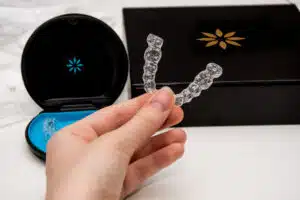Invisalign has transformed the way people approach orthodontic treatment, yet misconceptions still surround it. From doubts about effectiveness to assumptions about cost, these myths often prevent individuals from considering this innovative solution. Let’s clear up the confusion and explore the truth behind the most common misconceptions about Invisalign.
1. Believing Invisalign Aligners Are Hard to Maintain

Maintaining Invisalign aligners is simpler than many people think. Rinse them with lukewarm water and clean them gently with a soft toothbrush. Avoid using hot water to prevent warping. Storing them in their case when not in use prevents damage or loss. A little consistency ensures the aligners stay clean and effective without much effort.
2. Assuming Invisalign Aligners Are Noticeable
Invisalign aligners are designed to be discreet. The clear, smooth plastic makes them nearly invisible when worn, so most people won’t notice them during conversations or social interactions. This feature sets Invisalign apart from traditional braces, offering a more subtle way to improve your smile.
3. Thinking Treatment Is Painful or Uncomfortable
Invisalign aligners prioritise comfort. Unlike traditional braces, which have wires and brackets that can irritate your mouth, Invisalign’s smooth edges fit snugly around your teeth. While you may feel slight pressure as your teeth shift, it’s far less invasive than the discomfort often associated with braces.
4. Believing You Can’t Eat Your Favorite Foods
Invisalign gives you the freedom to enjoy your favorite meals. Remove the aligners before eating, and you can indulge without restrictions. This flexibility sets Invisalign apart from braces, which often limit food choices. To stay on track with your treatment, wear the aligners as prescribed after eating and clean your teeth before putting them back in.
5. Thinking Invisalign Is Only for Minor Issues
Invisalign addresses more than just minor adjustments. It can correct issues like overcrowding, gaps, overbites, underbites, and crossbites. Dentists and orthodontists customise each treatment plan to tackle both simple and more advanced alignment problems. This makes Invisalign a versatile option for a wide range of patients.
6. Believing Invisalign Is Slower Than Braces
Invisalign treatments can match the pace of traditional braces for many cases. The timeline depends on the severity of the alignment issue and the patient’s commitment to wearing the aligners as directed. For mild to moderate corrections, Invisalign often works just as quickly, making it a time-efficient alternative.
7. Assuming It’s Only for Teens and Young Adults
Invisalign works for all age groups, including adults and seniors. Many adults opt for this option to straighten their teeth discreetly without the noticeable look of metal braces. Its growing popularity among older individuals shows that it’s never too late to invest in a healthier smile.
8. Thinking It’s Too Expensive to Consider
Invisalign’s cost is comparable to traditional braces, and many orthodontic practices offer payment plans to make it affordable. The total expense depends on the length and complexity of the treatment, but insurance often covers part of the cost. This makes Invisalign a viable choice for many budgets.
9. Thinking Invisalign Doesn’t Require Professional Oversight
Orthodontist oversight is essential for successful Invisalign treatment. Professionals monitor your progress, ensure the aligners fit correctly, and make adjustments as needed. Regular check-ins help track alignment improvements and confirm the treatment stays on schedule. Without proper guidance, the results may not meet expectations, emphasising the value of professional support throughout the process.
10. Assuming It’s Not as Effective as Traditional Braces
Invisalign delivers results comparable to traditional braces when patients commit to wearing the aligners consistently. The aligners apply precise pressure to guide teeth into their desired positions. Following the prescribed schedule and wearing them for the recommended hours ensures the treatment’s effectiveness. With proper use and professional supervision, Invisalign achieves the same level of success as braces.
Conclusion
Misconceptions about Invisalign often cloud its benefits. It’s versatile, effective, and accessible for many patients. Professional oversight, commitment to the treatment plan, and proper care make Invisalign a strong option for those seeking a discreet solution to orthodontic issues. Consulting an orthodontist can help clarify doubts and determine if it’s the right fit for your needs.
FAQs
Is Invisalign covered by dental insurance?
Many dental insurance plans offer partial coverage for Invisalign, similar to traditional braces. Coverage depends on the specific policy, so it’s best to review your plan or consult your insurance provider.
How long do I need to wear Invisalign aligners each day?
For optimal results, you should wear Invisalign aligners for 20 to 22 hours daily. This includes wearing them while sleeping, only removing them for eating, drinking, and cleaning your teeth.
Can I drink beverages other than water while wearing Invisalign?
It’s best to remove your aligners before drinking anything other than water. Sugary or acidic beverages can seep into the aligners, increasing the risk of tooth decay. Hot drinks can also warp the aligners.
How often will I need new aligners during treatment?
You’ll typically switch to a new set of aligners every one to two weeks, depending on your orthodontist’s recommendation and the progress of your treatment.
Can I use Invisalign if I’ve had braces before?
Invisalign is often a great option for individuals who have had braces and need minor adjustments. Consult an orthodontist to determine if it suits your current dental needs.
What happens if I lose an aligner?
If you lose an aligner, contact your orthodontist immediately. They may recommend using your previous aligner or moving on to the next one until a replacement is available.
How do I know if Invisalign is right for me?
Invisalign works for most alignment issues, but not all. Schedule a consultation with an orthodontist to evaluate your dental needs and determine if Invisalign is a suitable treatment option.






